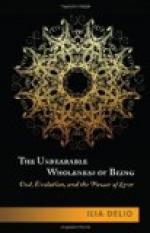There is a very important fact which must not be overlooked. All the nations dwelling on the shores of the Mediterranean, Semites, and Egyptians, as well as Greeks and Romans, had been accustomed to the worship of female deities. In the minds of the ancient peoples, woman, the symbol of sex, had always been endowed with qualities of magic and mystery. There was something supernatural in her power of bringing forth a living specimen of the race, and in all cults the maternal woman occupied a very important position. Had Christianity suddenly destroyed this ancient and natural need? We know that the Church had assimilated a great number of antique superstitions; nor were the female deities sacrificed. The great Asiatic Mothers had not been forgotten; the very ancient Babylonian Istar (Astarte), Rhea Kybele of Asia Minor, and above all the Egyptian Isis, still lived in the heart of man,—subconsciously, probably—as lofty, sacred memories, but nevertheless influencing his life. The Egyptian Isis with Horus in her lap is the direct model of the Madonna with the Child. She represented earth, bringing forth fruit without fertilisation. “This religious custom (the worship of Isis),” says Flinders Petrie, “exerted a powerful influence on nascent Christianity. It is not too much to say that without the Egyptians we should have had no Madonna in our creed. The cult of Isis was widely spread at the time of the first emperors, when it was fashionable all over the Roman Empire; when later on it merged into that other great religious movement, and fashion and conviction could be combined, its triumph was assured.”
Advancing Christianity had depopulated the national pantheon. There must have been a great sense of loss, especially among the lower classes, and it does not require much psychological insight to realise that it was the lack of female deities which more especially roused a feeling of anxiety and distress. The masses were yearning for a goddess, and it was at Ephesus, the classical seat of the hundred-breasted Diana, that the stolen divinity was restored to them. The theologians were divided into three camps. While some of them regarded Mary merely as “the mother of man” others acknowledged her as the “Mother of God,” and Nestorius suggested as a compromise the title “Mother of Christ.” At the synod of Alexandria, in the year of grace 430, and at the council of Ephesus in 431, Nestorius was found guilty of blasphemy and deprived of his bishopric. Henceforth Mary was [Greek: Theotochos], the “Mother of God,” and her worship was sanctioned by the Church. “Through Thee the Holy Trinity has been glorified,” exclaimed Cyril joyfully, “through Thee the Cross of the Saviour has been raised! Through Thee the angels triumphed, the devils were driven back; the tempter was beaten and human nature uplifted to Heaven; through Thee all intelligent creatures who were committing idolatry, have learned the truth!” Loud rejoicing filled




